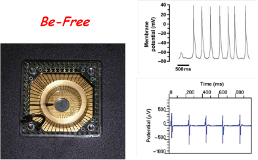Rapid screening to detect illicit treatment with beta-agonists (BE-FREE) - CONCLUDED
Aree / Gruppi di ricerca
Partecipanti al progetto
- Carabelli Valentina (Coordinatore/trice)
- Calorio Chiara (Dottorando/a)
- Carbone Emilio (Docente)
- (Assegnista)
- Guarina Laura (Dottorando/a)
- Marcantoni Andrea (Ricercatore/trice)
Descrizione del progetto

Members of other units:
Elena Bozzetta (Istituto Zooprofilattico)
Marta Leporati (Centro Regionale Antidoping)
Di Quaglia Andrea (Floramo)
Roberto Becattini (Crisel)
Erasmo Chessa (Trustech)
Partners:
Istituto Zooprofilattico Sperimentale
Centro Regionale Antidoping
Floramo Corporation Srl
Crisel Instruments
TRUSTECH
Sponsors:
Polo di Innovazione BioPmed
Regione Piemonte - Fondi: P.O.R. - F.E.S.R. 2008/2014
Description
B-adrenergic agonists are commonly used in medicine and veterinary practice as bronchodilators in the treatment of pathologies of the respiratory apparatus. Though, the same molecules are often illegally used to increase the muscle mass and improve the competitive performance of athletes, leading to neurological, cardiac and metabolic adverse effects, thus representing serious risk to human health.
Purpose of the BE-FREE project is to realize a “user-friendly” device, supplied with a microfluidic system and a software controller, to detect the presence of illecit usage of b-adrenergic agonists in the meat for human consumption.
The BE-FREE project, supported by the Regione Piemonte (Poli di innovazione BioPmed), aims at developing new toxicological tools for detecting the illicit usage of b2-agonists in meat for human consumption: detection methods are based on the measurement of cardiac electrical activity alteration through the use of multi-electrode arrays (MEA).
In collaboration with the IZSTO (http://www.izsto.it/) and the Regional Antidoping Center (http://www.antidoping.piemonte.it/cms/), the BE-FREE device will be applied to monitor the sino-atrial node activity of animals from slaughter and measure several parameters associated to the tissue functionality, such as cardiac frequency, action potential duration and shape, as well as velocity of AP conduction after prolonged use of b2-agonists (clenbuterol, fenoterol, salbutamol). These assays are characterized by high sensitivity and rapid responses. They can be easily repeated and thus provide a test of sample tissue functionality.
As further application, the same device can be used for in vitro applications to test the action of b2-agonists extracted from the urine of human or animal donors.
Keywords:
B-agonist, Clenbuterol, Sino-atrial node, Chromaffin cells, Spontaneous firing, Ca2+ channels, Biosensors, Doping, Multi-electrode array (MEA), Patch-clamp, Drug-screening




